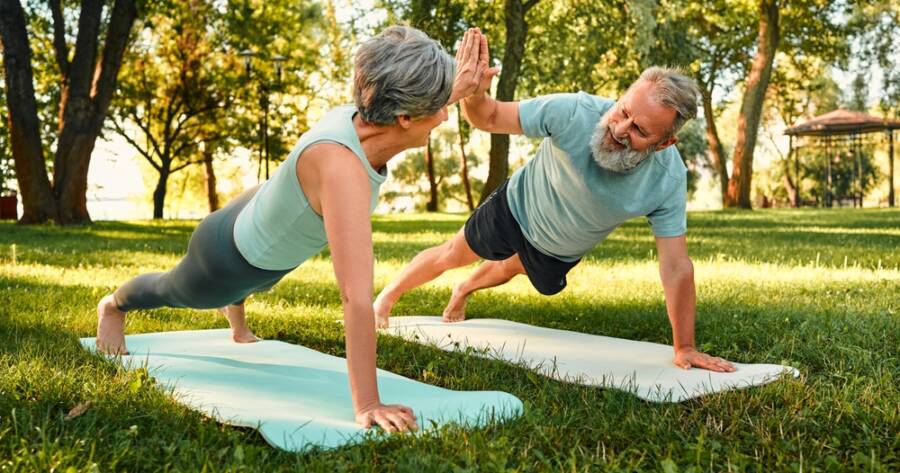Balance and stability might not sound as exciting as cardio or strength training, but they’re essential for moving well and staying injury-free, especially as you age. These exercises strengthen the muscles that support your joints, improve coordination, and help prevent falls and strains. Whether you’re walking, lifting, or simply getting out of a chair, better balance means better performance. The best part? You don’t need fancy equipment–just a little intention and consistency.
Why Balance Training Matters More Than You Think
Good balance isn’t just for dancers or athletes, it’s essential for everyday life. From walking and climbing stairs to bending, lifting, or simply standing on one leg, your balance impacts nearly every movement you make. As you age, maintaining it becomes even more important to prevent falls, injuries, and loss of independence.
Balance workouts strengthen the stabilizing muscles in your core, hips, ankles, and legs, which improves coordination and joint health. Without this foundation, your body may compensate in ways that increase the risk of strain or instability. Prioritizing balance helps your body move more efficiently, reduces fatigue during physical activity, and helps you feel more in control, literally and mentally.
The Link Between Balance and Injury Prevention
Poor balance can lead to missteps, rolled ankles, or awkward landings, all of which increase the likelihood of injury. By improving your stability, you give your body the tools it needs to recover quickly from stumbles and move with more confidence. Balance exercises train your body to react faster and more precisely.
This is especially important for anyone recovering from injury, managing joint issues, or looking to stay active long-term. When your core and stabilizer muscles are strong, they protect your spine, hips, knees, and ankles from unnecessary stress. Balance training doesn’t just support your current workouts, it makes them safer and more effective, now and in the future.
How to Incorporate Balance into Your Routine
You don’t need a separate workout to train your balance, you can integrate it into your current routine. Try standing on one leg while brushing your teeth, performing squats on an unstable surface, or holding walking lunges for a beat longer than usual. Simple tweaks create more engagement and control.
If you prefer a structured approach, set aside 10–15 minutes a few times a week to practice balance-focused moves. Exercises like single-leg deadlifts, heel-to-toe walks, or standing on a BOSU ball are great options. Yoga and Pilates are also excellent for improving balance through slow, controlled movements. The key is consistency. Small, regular efforts yield lasting benefits.
Strengthen Your Core, Strengthen Your Balance
Your core muscles are the control center for balance and stability. When your abs, obliques, and lower back are strong, your body has a solid foundation to support every movement—from sitting upright to catching yourself during a slip. Without core strength, other muscles may overcompensate, leading to poor form and potential injury.
Incorporating exercises like planks, bird dogs, and seated leg lifts into your week can greatly improve both balance and posture. You don’t need to spend hours on core training, just a few focused minutes each session can make a big difference. A strong core not only helps you stay upright but also improves your overall coordination and movement efficiency.
Balance Training for Every Age and Fitness Level
No matter your age or ability, balance workouts can (and should) be part of your wellness routine. For younger adults, they enhance performance in sports and daily movement. For older adults, they’re critical for maintaining independence and preventing falls, which are a leading cause of injury in seniors.
Modifications make balance training accessible for everyone. Beginners can start by holding onto a wall or chair while trying single-leg stands. More advanced movers can progress to stability balls, balance boards, or dynamic movements. The important part isn’t complexity, it’s consistency. Over time, even simple exercises build the neural and muscular connections that keep you steady.
Add Variety for Better Results
Like any type of fitness, balance training works best when it’s varied and engaging. Try mixing static exercises (like tree pose) with dynamic ones (like stepping sideways over a low object). The body adapts when it’s challenged in new ways, so change up your surface, speed, or sequence to keep things interesting.
You can also turn balance practice into play. Stand on one foot during TV commercials, try a quick agility drill in your driveway, or dance to your favorite playlist. These small moments train your body in real-life scenarios, where balance matters most. The more you enjoy it, the more likely you’ll stick with it, and the better your results will be.
A Stronger, Safer You Starts with Stability
Balance and stability training may not be flashy, but they quietly lay the foundation for everything else you do. From building strength and coordination to protecting against injury, these exercises help your body move with more purpose and less strain.
When you train your balance, you’re not just improving your workouts. You’re improving how you live, walk, move, and age. Make time for it, stay consistent, and you’ll feel the difference with every step, stretch, and stride.

